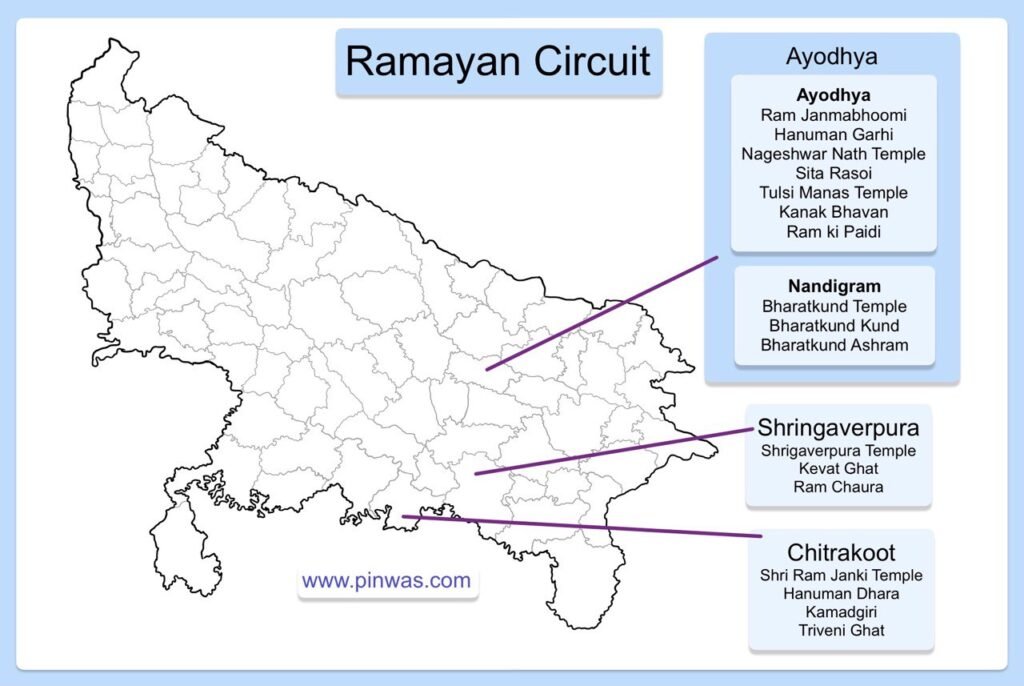Introduction
The Ramayana Circuit, a tourism initiative by the Government of India, unfolds the religious and cultural tapestry of the country, specifically focusing on the revered epic Ramayana.
Fifteen destinations have been identified by the Government for development of tourism under the Ramayana Circuit.
The Ramayana Circuit, part of the Swadesh Darshan scheme by the Ministry of Tourism, is among the fifteen thematic circuits earmarked for development. The initial destinations include Ayodhya, Nandigram, Shringverpur, and Chitrakoot in Uttar Pradesh, as well as Sitamarhi, Buxar, and Darbhanga in Bihar. Additionally, the circuit encompasses Chitrakoot in Madhya Pradesh, Mahendragiri in Odisha, Jagdalpur in Chattisgarh, Nashik, and Nagpur in Maharashtra, Bhadrachalam in Telangana, Hampi in Karnataka, and Rameshwaram in Tamil Nadu.

Ramayan Circuit and UP
Four of the 15 Ramayana Circuit sites are located in Uttar Pradesh:
- Ayodhya
- Nandigram
- Shringverpur
- Chitrakoot
Ayodhya
Ayodhya, an ancient city nestled along the banks of the River Sarayu in Uttar Pradesh, holds a distinguished place among the seven holiest cities in Hinduism. Renowned as the birthplace of Lord Rama, the central figure of the Ramayana, Ayodhya stands as a prominent pilgrimage destination for Hindus, boasting several significant religious sites:
- Ram Janmabhoomi: Revered as the birth site of Lord Rama, currently hosting a mosque with ongoing discussions about constructing a temple.
- Hanuman Garhi: Designed like a fortress and reached by seventy-six steps, this ancient temple from the 10th century sits at the heart of the pilgrim town. With circular fortifications in each corner, it is thought to be the dwelling place where Lord Hanuman safeguarded the town from a cave. The temple houses a golden idol of Lord Hanuman, ranking among the most revered. Every day, numerous devotees flock to Hanumangarhi to pray, seeking protection from evil and blessings for happiness and prosperity.
- Ramkot: Perched on elevated ground and embellished with an array of temples and shrines, this site emerges as a key attraction in Ayodhya. The exuberant celebration of the Ram Navami festival unfolds in the month of Chaitra (March-April) on the Hindu calendar, attracting pilgrims from around the globe to honor Lord Ram in this lively and festive season.
- Shri Nageshwar Nath Temple: Lord Nageshwarnathji is the principal deity of Ayodhya, with the belief that the exquisite temple dedicated to him was constructed by Lord Ram’s son, Kush. The ancient shivalinga housed here holds great significance. According to legend, while bathing in the Saryu River, Kush lost his armlet, which was returned to him by a nag kanya (snake woman). They fell in love, leading Kush to build the temple for her. This revered temple, dating back to 1750 AD, is a focal point during the Mahashivaratri festival, drawing devotees from far and wide.
- Sita Rasoi: A temple representing the kitchen of Sita, Lord Rama’s wife.
- Tulsi Smarak Bhawan: Tulsi Smarak Bhawan is a tribute to the revered saint-poet Goswami Tulsidas Ji, hosting routine prayer sessions, devotional concerts, and religious discussions. The complex includes Ayodhya Shodh Sansthan, featuring an extensive collection of literary works on Goswami Tulsidas Ji. A highlight is the daily Ramleela performance from 6:00 pm to 9:00 pm at the Tulsi Smarak Auditorium, drawing significant attention.
- Kanak Bhawan: In 1891, Queen Vrishbhanu Kuvari of Teekamgarh, Madhya Pradesh, erected a beautifully adorned temple. The central temple encloses an open inner space that hosts the revered shrine of Rampada. Witness the splendor of the intricate idols featuring Goddess Sita, Lord Ram, and his three brothers.
- Treta ke Thakur: Known as Kaleram-ka-Mandir, this exquisite temple is thought to commemorate the location where Lord Ram conducted the legendary Ashwamedh Yagna. The current structure, constructed approximately three centuries ago, was commissioned by the Raja of Kullu in Himachal Pradesh and subsequently restored by Maharani Ahilyabai Holkar of Indore in Madhya Pradesh. The statues within are crafted from black sandstone, believed to date back to the era of King Vikramaditya.
- Ram ki Paidi: Aligned along the Saryu River, a sequence of ghats acts as sanctuaries for devotees seeking spiritual purification through ritualistic cleansing. Surrounded by temples and lush green gardens, the riverfront presents a breathtaking panorama, particularly in the illuminated night. Devotees believe in the purifying power of the holy river as they immerse themselves in its waters. The maintenance of these ghats is entrusted to the Irrigation Department, Government of Uttar Pradesh, ensuring a steady water supply from the Saryu.
- Jain Shrine In Ayodhya: Beyond being the birthplace of Lord Ram, Ayodhya holds profound significance for Jains, believed to be the birthplace of five Jain Tirthankars. Devotees flock to this town annually to pay homage to these revered saints and partake in special occasions. Numerous Jain temples are scattered across Ayodhya, including the Lord Adinath Temple near Swargdwar, Lord Anantnath Temple at GolaGhat, Lord Sumantnath shrine at Ramkot, Lord Ajitnath Temple near Saptsagar, and Lord Abhinandannath Temple in the Sarai locality. Notably, Raiganj area houses a substantial Jain temple featuring an exclusive 21 ft tall idol of Lord Adinath (Rishabhdevji), the first Tirthankar.
- Other: Mani Parvat, Choti Devkali Temple, Queen Huh Memorial Park, Gurudwara, Suraj Kund, Gulab Bari, Tomb of Bahu Begum, Company Garden, Guptar Ghat etc.
‘Queen Hum Memorial Park’
|
Beyond its religious significance, Ayodhya draws tourists with its vibrant and multicultural ambiance, steeped in rich history and culture. A compelling destination for those intrigued by Hindu religion and culture, Ayodhya stands as a testament to the spiritual and historical legacy of India.
Nandigram (Bharatkund)
Bharatkund, situated in the Sohawal tehsil of Ayodhya district, Uttar Pradesh, stands as a village and revered religious site, located 19 km (12 mi) to the south of the district headquarters, Ayodhya city.
Historical and Religious Significance:
Bharatkund holds profound importance in the Hindu epic Ramayana, being the site where Bharat, Lord Rama’s brother, first encountered him after the 14-year exile imposed on Rama. This poignant reunion unfolded when Bharat ruled Ayodhya in Rama’s stead during his exile.
Religious Sites in Bharatkund:
- Bharatkund Temple: Dedicated to Lord Rama and Bharat.
- Bharatkund Kund: A sizable pond believed to be the locale of Bharat’s meeting with Rama.
- Bharatkund Ashram: The ashram where Bharat is said to have resided during the period of Rama’s exile.
Pilgrimage and Tourism:
Bharatkund has evolved into a significant pilgrimage destination attracting Hindus globally. Beyond its religious allure, the village serves as a popular tourist destination, offering a profound opportunity to delve into the narrative of the Ramayana.
Key Details:
- Location: Sohawal tehsil, Ayodhya district, Uttar Pradesh, India
- Distance from Ayodhya: 19 km (12 mi)
- Significance: Crucial site in the Hindu epic Ramayana
- Notable Sites: Bharatkund Temple, Bharatkund Kund, Bharatkund Ashram
- Popularity: Revered pilgrimage site and sought-after tourist destination.
Shringverpur
Shringaverpur, an ancient city nestled in the Prayagraj district of Uttar Pradesh, India, holds a significant position on the banks of the River Ganga, adorned with numerous religious landmarks.
Historical and Religious Importance:
- Shringaverpur is intricately linked to Hinduism, specifically to Lord Rama and Sita. According to the Ramayana, during Lord Rama’s 14-year exile, he and Sita found solace in Shringaverpur for a night. King Nishadraj extended hospitality to the divine couple during their stay.
- A noteworthy excavation at Shringaverapur reveals an impressive complex featuring four water tanks, showcasing a high degree of hydraulic engineering. Constructed using millions of bricks, these tanks, spanning approximately 250 meters in length and 38 meters in width, demonstrate advanced water management. The ingenious system involved channeling water from the Ganga River through a meticulously engineered canal.[Kushan Age]

Religious Sites in Shringaverpur:
- Shringaverpur Temple: A sacred edifice devoted to Lord Rama and Nishadraj.
- Kevat Ghat: Located on the Ganga’s banks, it commemorates the spot where Kevat aided Lord Rama, Sita, and Lakshman in crossing the river.
- Ramchaura: A site where Lord Ram rested for a night along the Ganga’s banks.
Pilgrimage and Tourism Hub:
Shringaverpur serves as a revered pilgrimage destination, drawing thousands of devotees annually. Beyond its religious significance, it has become a prominent tourist attraction in the vicinity of Prayagraj.
Key Features:
- Location: Prayagraj district, Uttar Pradesh, India
- Associated Deities: Shri Rama and Sita
- Noteworthy Sites: Shringaverpur Temple, Kevat Ghat, Ramchaura
- Visitation: Lakh of devotees visit annually for spiritual fulfillment.
- Tourism: A major tourist destination in the proximity of Prayagraj.
Chitrakoot
Location:
Chitrakoot is a religious and historical city situated in Uttar Pradesh, India. Renowned for its association with Lord Rama’s exile period, it attracts visitors with its religious sites and natural beauty.
Tourist Attractions:
- Shri Ram Janaki Temple: Dedicated to Lord Ram and Mother Sita, this temple stands as the most renowned in Chitrakoot.
- Hanuman Dhara: A sacred pond believed to be the site of the first meeting between Lord Rama and Hanuman.
- Kamadgiri: A hill considered the penance place of Lord Rama and Mother Sita.
- Triveni Ghat: A sacred ghat where three rivers, Tamsa, Bhardwaj, and Mandakini, converge.
Religious and Cultural Importance:
Chitrakoot, with its temples, ashrams, and religious landmarks, is not only a haven for those seeking spirituality but also a place of cultural significance. Its serene atmosphere and natural allure make it an ideal destination for both religious pilgrims and nature enthusiasts.
Significance
Religious Significance:
- Allows pilgrims to visit sacred locations linked to the Ramayana, drawing Hindu tourists globally.
Cultural Significance:
- Showcases Indian art, architecture, music, dance, and cuisine, offering a rich cultural experience.
Economic Significance:
- Expected to boost local economies by creating jobs in the tourism sector and fostering infrastructure development.
Interfaith Harmony:
- Provides a platform for people of different faiths, including Hindus, Muslims, and Sikhs, to come together and celebrate their shared heritage through the universal story of the Ramayana.
Development Status:
- The Ayodhya Circuit is currently under development, with a commitment from the Government of India to substantial investment. The project is slated for completion by 2025.
Anticipated Impact:
- A unique opportunity to promote tourism, culture, and interfaith harmony in India, attracting millions of visitors worldwide and significantly influencing the economy and culture of the covered regions.
